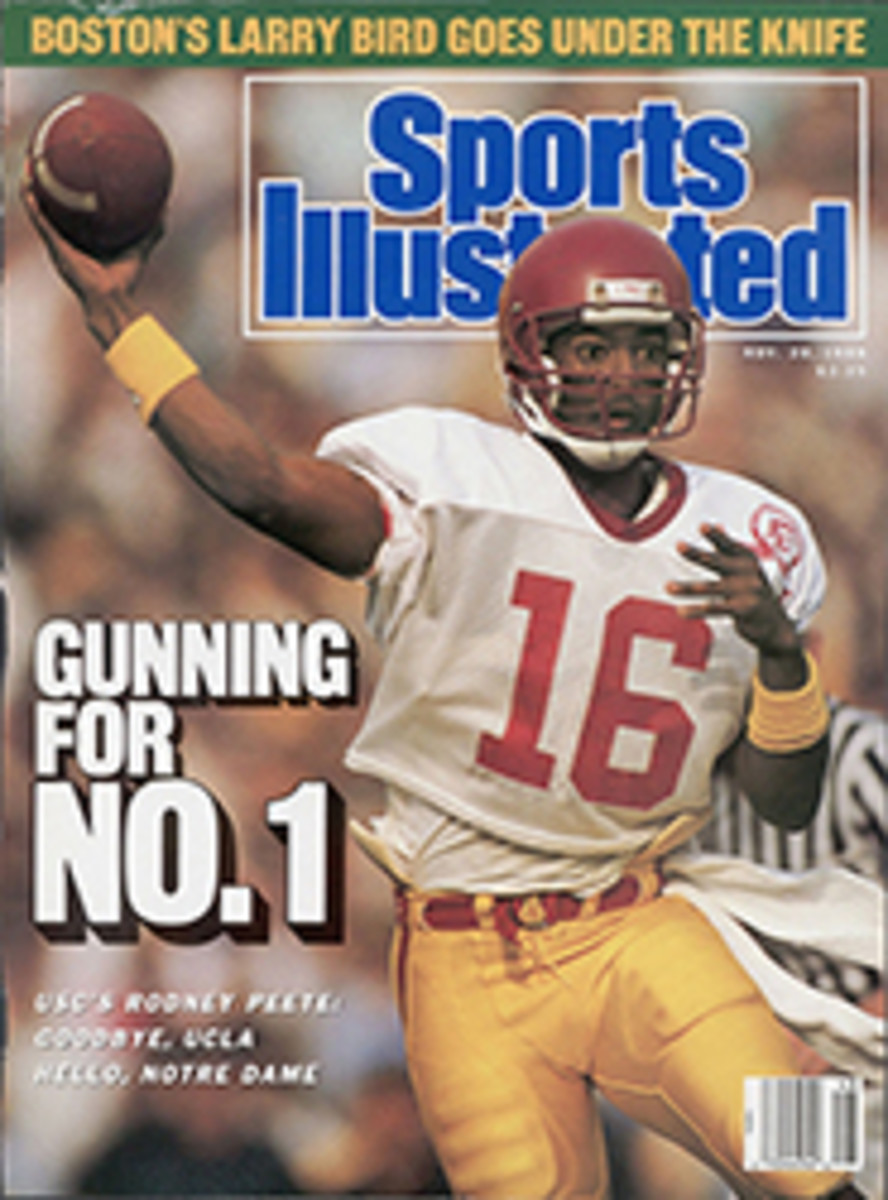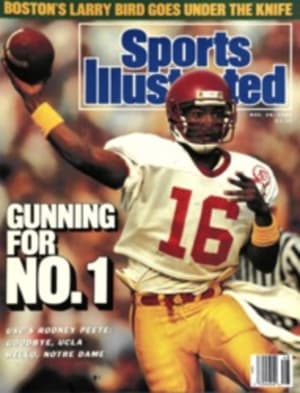
Letters
CHAIKIN'S EXAMPLE (CONT.)
One word describes Tommy Chaikin—courageous (The Nightmare of Steroids, Oct. 24). The story he and Rick Telander presented was remarkable. As a high school baseball player, I am aware of how easily steroids can be purchased. But what bugs me most are the coaches who know that their players are on this deadly drug yet do nothing about it.
I'm not suggesting that all coaches turn their backs on the use of steroids, but many do. I ask those coaches: Is it worth it? Are you so selfish that you would risk the lives of your players to win? I'm the first to admit that the athletes are at fault for exercising poor judgment, but the coaches must also take a stand against steroids. Please.
BOB STELLING
Lockport, Ill.
As the mother of a 13-year-old boy, I want to thank Tommy Chaikin for his article. I don't think telling kids to "just say no" is enough. We need to tell them, as Chaikin did, why to say no.
KAREN ADAMS STONE
Goodland, Kans.
The story scared the hell out of me and opened the eyes of my two sons.
MADISON T. BROWN III
Master Sergeant, USAF
Wurtsmith AFB, Mich.
I am a 14-year-old sophomore football player at my high school. During the off-season I enjoy weightlifting. I always thought steroids had bad side effects, but I never realized that those side effects could be so dire. This article sends an important message to young athletes.
ALEX MASCIARELLI
Canton, Mass.
It's not just the Tommy Chaikins who are hurt by steroids. The thousands of athletes who play by the rules are at a severe disadvantage.
MICHAEL A. ANDERSON
Northbrook, Ill.
Thumbs down on the story by Tommy Chaikin. Sure there is a steroid problem in high schools and colleges, but no one forced him to take drugs for three years. Nor did he ask for help while he was trying to make himself strong and big. South Carolina gave him a free education and all the glory that goes with big-time college football, and in return he points a finger at coaches, teammates and doctors. What a friend!
Don't blame someone else for your mistakes, Chaikin.
ROBERT A. GRANT
High Point, N.C.
INJURED QUARTERBACKS
I was interested in Paul Zimmerman's article (What a Downer, Oct. 31) about the alarming number of injuries to NFL quarterbacks. I agree that additional rule changes are not the answer. It seems to me that the refs already have a regulation that deals with overly aggressive defensive players. In case the refs have forgotten, it's called "unnecessary roughness."
DANIEL J. WILKIE
Milwaukee
As a high school defensive lineman, I was taught to "stay home" for a certain count in order to find the football before recklessly rushing the quarterback. By staying home, the defensive lineman can be in position to make the tackle on running plays that develop quickly. However, the current play selection in the NFL favors the pass, and the majority of the running plays are the kind that develop slowly, such as sweeps, reverses and draws. In the absence of quick, straight-ahead running plays, the defensive linemen—and the blitzers—are encouraged to ignore the run and go for the quarterback.
JOHN R. MARKLEY
Lancaster, Pa.
Zimmerman made a number of salient points about quarterback vulnerability. What he didn't mention is that the hard-hitting "tweeners"—those big defensemen who are also fast—may have been chemically created, a phenomenon that is graphically depicted in the Tommy Chaikin story.
RICHARD HOFFMAN, M.D.
Portland, Ore.
I would ascribe the staggering rate of severe football injuries today as much to modern equipment as to strategy, size, strength and steroids. Paradoxically, each new "safety" feature added to the player's armor means another weapon with which to maim a momentarily unprotected opponent. Pneumatic helmets with face masks, mega-shoulder pads and arm protectors effectively insulate the defenders. Freed from concern about broken noses, cracked clavicles and the like, they can launch themselves at a quarterback whose vulnerable joints are—as they must be for mobility—quite unprotected.
STEPHEN R. FAHEY, M.D.
Staff Physician, University Health Services
University of Maryland
PENN STATE VS. SYRACUSE
The decision by Penn State to discontinue its football series with Syracuse (COLLEGE FOOTBALL, Oct. 24) follows on the heels of last year's new season-ticket policy. Penn State's national championship in 1986 greatly increased the demand for tickets, and the university announced that season-ticket holders who did not contribute to the Nittany Lion Club would not receive their previous allotment but, rather, would have the number reduced. On the other hand, an annual contribution to the Nittany Lion Club would enable one to retain the original number of season tickets. Penn State gave Syracuse a lesson in $tradition$, just as it gave certain season-ticket holders a lesson in $loyalty$.
PHYLLIS REINHART
Gilbertsville, Pa.
NIGHT AND DAY
Ron Fimrite's POINT AFTER (Oct. 31) lamenting the disappearance of day games from the World Series hit the nail on the head.
One other point: Fimrite mentioned the discomfort of the fans who have to deal with chilly weather when attending night games in October. As a first baseman for a Loyola (Chicago) University club that has played a lot of games in cold weather, I can assure you that the players have it worse.
TONY MURRAY
Wilmette, Ill.
When my daughter and son nod off by the second inning of late-night games, only to wake up in the morning asking, "What happened in the World Series?" I know something is wrong.
KEVIN KELLY
Londonderry, N.H.
I work during the day, and I can't "sneak away" from my job. Nor would it be appropriate for me to walk around with a transistor radio stuck in my ear. I attend or view on television approximately 150 games a year, and Fimrite's suggested reward for my loyalty to baseball is to deny me a chance to see the sport's ultimate event. Have some warm milk and go to bed early if you want to, Ron, but don't try to take the World Series away from us working stiffs.
MIKE HOLCOMB
Buford, Ga.
The solution is to compromise. Baseball and the networks should revert to a formula used earlier: day games on weekends and night games during the week.
CHRIS PAYNE
Richmond
CHANG'S EXAMPLE
As a 14-year-old tennis player, I have seen, at junior tournaments, players trying to imitate Andre Agassi. They wear denim shorts, hit a forehand as hard as possible and have punkish haircuts. I'm grateful that you have given Michael Chang the credit he deserves (Tennis Is Chemistry, Oct. 17). In my opinion, he should be considered more a role model than Agassi. Chang has proved that you can be yourself, with no showboating, and still be one of the best and most fun-to-watch players in the game.
MICHAEL IRANI
Front Royal, Va.
MIAMI VS. NOTRE DAME
My brother Skip, the man in the clerical collar and black sweatshirt standing next to an unidentified Notre Dame student in these pictures, is the first University of Miami graduate to become a Catholic priest. He is a Maryknoll missionary who serves as the only Catholic chaplain in the Florida state prison system. Thirty-two years ago, when Skip was a sixth-grader at Epiphany Parochial School in South Miami, a nun made him stand in the corner of the classroom because he refused to join in a prayer for a Notre Dame victory over Miami in football. This Oct. 15, the day the Irish beat the Hurricanes 31-30 (Pluck of the Irish, Oct. 24), Skip and I recalled that incident as we walked away from the din of Notre Dame Stadium and passed by the shadow of Touchdown Jesus. We knew in our hearts that our hometown team had not been outplayed—just outplayed.
MIKE FLYNN
Miami
BEETLE'S CHALLENGE
As the leisure-time services supervisor at the Danville (Ill.) Correctional Center, I noted the challenge to powerlifters in the 242-pound class issued by inmate Gregory (Beetle) Lowe of the State Correctional Institution in Graterford, Pa. (Sports Behind the Walls, Oct. 17). On behalf of Danville inmate John Clay (left), I wish to respond. Our Mr. Clay lifted a combined total of 2,039 pounds (39 pounds more than Lowe's total) in a meet sanctioned by the American Drug-Free Powerlifting Association (ADFPA) in Chicago in May. Clay's bench press of 485 pounds, squat of 782.5 pounds and deadlift of 771.5 pounds added up to an ADFPA record that stood until August, when it was broken by Andrew (Bull) Stewart of West Point, Miss.
KEITH O. NELSON
Danville, Ill.
TWO PHOTOS
MIKE FLYNN
PHOTO
DAVID WALBERG
Letters to SPORTS ILLUSTRATED should include the name, address and home telephone number of the writer and should be addressed to The Editor, SPORTS ILLUSTRATED, Time & Life Building, Rockefeller Center, New York, N.Y. 10020-1393.

